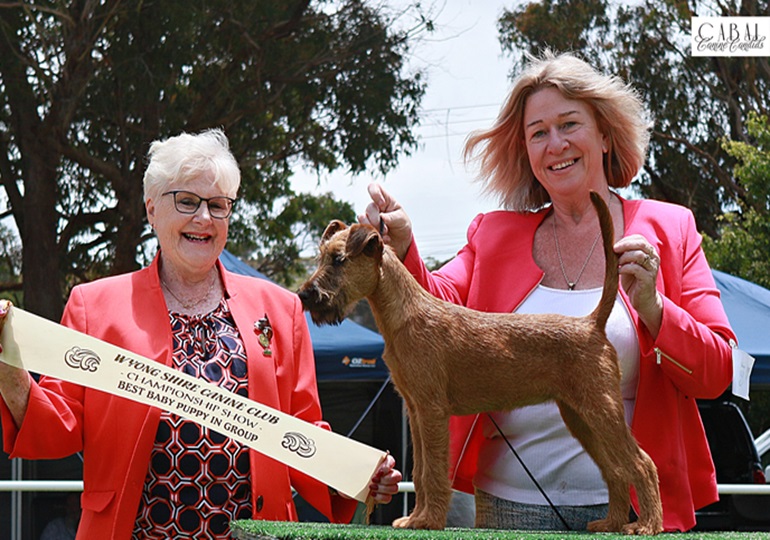Breeds
Irish Terrier

GROUP 2 - TERRIERS
History
The Irish Terrier is a dog breed from Ireland, considered one of the oldest terrier breeds. It is believed to have descended from the black and tan terrier-type dogs of Britain and Ireland, just like the Kerry Blue and Irish Soft-haired Wheaten Terriers in Ireland or the Welsh, Lakeland and Scottish Terriers in Great Britain. 1.
F. M. Jowett writes in The Irish Terrier, 'Our Dogs' Publishing Co. Ltd., Manchester, England 1947 – 7th Edition: They are described by an old Irish writer as being the poor man's sentinel, the farmer's friend, and the gentleman's favourite. These dogs were originally bred not so much for their looks as for their working qualities and gameness, the Irish Terrier being by instinct a thorough vermin killer. They were formerly of all types and of all colours – black-and-tan, grey-and-brindle, wheaten of all shades, and red being the predominant colours. Colour or size evidently did not matter if they were hardy and game." 1.
The proper selection process of the breed began only in the latter 19th century. They were shown now and then, sometimes in one class, sometimes in separate classes for dogs under and over 9 pounds. 1.
The first breed club was set up in Dublin in 1879. Irish Terriers were the first members of the terrier group to be recognised by the Kennel Club as a native Irish Breed – this happened just before the end of the 19th century. 1.
The first Irish Terriers were taken to the US in the late nineteenth century and quickly became somewhat popular. 1.
There used to be big influential kennels in Ireland, the Great Britain and US up to the 1960s as the beacme increasingly "fashionable" as a family pet because of its fondness for children. There is ambitious breeding in many continents, including Africa (South Africa), North America, (Northern) Europe and Australia. 1.
Appearance
An active, lively and wiry appearance; plenty of substance but free of clumsiness. Neither cloddy nor cobby but showing a graceful racy outline. 2.
Irish Terriers have medium-length tails and small, folded ears. The outer coat of the Irish Terrier is dense, wiry, and relatively short, while the undercoat is softer and lighter in colour. This double coat protects the dog from water and harsh weather. It is easy to groom and sheds only lightly. The Irish Terrier is usually a variation of red – red, red wheaten or yellow red, though some puppies are born with a white chest patch and some are born black and change colour as they age.
The average Irish Terrier dog stands 48 cm tall and weighs 12 kgs, bitches are 11kgs, and stand 46cms tall.
Temperament & Suitability
The Irish Terrier is very smart and willing to please, though he also tends to be strong-willed, independent and challenging. Early and consistent socialisation and basic obedience training help to ensure he will be a well-mannered member of your household, who is comfortable with family and friends. Training quickly establishes a bond between you and your Irish that will last a lifetime. Consistent use and reinforcement of early training should be a lifelong process. 3.
The Irish Terrier is a smart, quick dog who quickly adapts to new situations. This breed is great with children, when raised with them, and is deeply loyal to his owner. 3.
Irish Terriers are good with people. They have a highly developed sense of loyalty and it is important that they have a strong responsible leader, for whom they have natural respect. Most Irish Terriers love children and tolerate rough-housing to a certain extent. 3.
Irish Terriers need exercise; do not get one if you are not prepared to walk it. They enjoy training, new tasks are easily mastered with food and toys working equally well as motivation. They respond best to consistent, reward based training from a relaxed, authoritative person. 1.
Irish Terriers are often dominant with other dogs so early socialisation is a necessity. Most have strong guarding instincts and when these instincts are controlled, make excellent alarming watchdogs. 1.
GROOMING
The Irish Terrier's short coat requires regular brushing, stripping, and trimming to keep it in good condition. His dense and wiry broken coat hugs the body and creates a tight, water-resistant jacket. Underneath the stiff outer coat, a dense undercoat of softer, finer hair traps body heat on a cool, damp day. Ideally the outer coat should be hand-stripped rather than clipped. Weekly brushing will help to remove dirt and loose hair and keep the dog looking his best. The nails should be trimmed regularly, as overly long nails can cause the dog discomfort. 3.
EXERCISE
The Irish Terrier is lively, playful, and outgoing, possessing abundant energy. Irish Terriers are great athletes and need regular exercise, so a fenced backyard is ideal. Failing this, they require walking, always on a leash, several times a day to maintain mental and physical fitness. Although willful, the Irish Terrier wants to please his owner and excels as a show and performance dog. Obedience, agility, rally, earthdog, and flyball events provide an outlet for the breed's energy, natural athleticism, and intelligence. 3.
Health
Irish Terrier is a generally healthy breed. As with all breeds, the Irish Terrier's ears should be checked regularly for signs of infection, and the teeth should be brushed often, using a toothpaste designed for dogs. The life expectancy is around 12 – 15 years.
References:
1. Wikipedia.org
2. DOGS AUSTRALIA Breed Standard
3. American Kennel Club
In Conclusion
Now you know a little about the Irish Terrier and have decided this is the dog for you, or you would like more information, please make contact with the breed club or your State controlling body for purebred dogs. They will be able to give you information about available puppies and also suggest dog shows where you can see the breed and speak to breeders. In this way you will gain a better perspective of the Irish Terrier and its needs and whether this breed would suit your lifestyle.
Breeders



